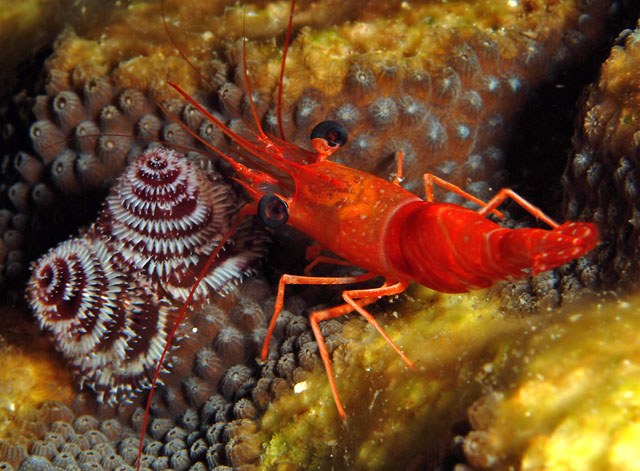
Don’t pay attention to the pretty, red Rhynchocienetes sp. shrimp. We’re talking about the brown stuff it’s walking over.
Dinoflagellates, aka Brown Slime “Algae” (they’re really protists): the nasty, bubbly, brown snot … and the bane of many aquarists.
A year ago, my neighborhood transformer blew, leaving several blocks of homes – including mine – without power for the greater part of a day. At the time, I didn’t have any form of backup power other than the two battery-powered air pumps I relied on to keep my corals and fish alive. The air pumps served this purpose well, but they couldn’t generate enough flow and oxygenation to keep my sandbed healthy. Soon after, nutrient levels climbed alarmingly fast from the die-off in my substrate, and the first dinoflagellates began cropping up. Thus began my year-long struggle with the brown menace.
Lesson #1: Install an automatic backup power system for your aquarium. Reefs are no small investments. They’re also exceedingly delicate, so backup power systems are critical. I am confident if I had power for proper circulation during the power outage, I would not be writing about how I beat dinoflagellates.
The Brown Slime Algae quickly grew to plague proportions. Literally EVERY inch of rock and my entire back glass was covered in thick, gooey slime. My snails were the first to die en masse. Dinoflagellates release toxins, of which snails are particularly susceptible to.
Lesson #2: If you have a bad case of dinoflagellates, remove your snails. As snails die off, they release incredible amounts of nutrients, fueling more dinoflagellate growth.
Lesson #2a: Deal with dinoflagellates as soon as they appear. Dinoflagellates kill. And as they kill, they “feed” on what they kill. It’s a vicious, self-fueling cycle that progressively worsens if you don’t deal with it.
For the next year, I would blast my rock with powerheads to dislodge the Brown Slime Algae (catching them with nets and/or filter socks), only for them to return a few days later. I tried raising pH (8.4+) with kalkwasser. I increased my magnesium levels above 1500mg/l. I performed huge water changes. I tried going months without water changes in hopes of starving the dinoflagellates. I reduced my lighting schedule, going so far as to run only actinics (no halides) for 6 hours per day for 2 weeks straight. I ran GAC. I ran ferric oxide. None of this worked. I was at wit’s end. So in early 2011, I planned a last ditch, multi-prong attack before giving up on my tank.
Here is how I finally beat dinoflagellates:
- I maintained my pH above 8.4 with kalkwasser.
- Before I began my final assault, I knew dinoflagellates would release a lot of toxins into the water column if I was successful. Therefore, the first step was to run lots of high quality granular activated carbon (GAC) to remove as much of these toxins as possible My GAC of choice was Two Little Fishies‘ Hydrocarbon.
- After my GAC was in place, I tried manually removing as much dinoflagellates as I could.
- Next, I decided to do a 72 hour black-out. I left every light off for a full 3 days and covered the entire tank/canopy under a black tarp so no light could creep in. Make sure to aggressively run your protein skimmer (or use air pumps) during this time as oxygen levels can get dangerously low.
- I prepared 50 gallons of new saltwater (using RO/DI water, of course). This represents about a 33% water change by water volume. I’d do a greater water change had I a container big enough to store the new water.
- After the 72 hour period, I removed the tarp and turned on my actinic lights. Most of the dinoflagellates was gone! I brushed off what remaining Brown Slime was clinging on to life and quickly began my water change, siphoning off any dinoflagellates I could find, in addition to siphoning my sand bed. I attempted to remove as much decaying matter I could. A 100 micron filter sock was installed in my sump to catch fine particulates.
- I prepared another 50 gallon saltwater mix and performed another water change. At this point, there was no visible dinoflagellates left to extract, and I did a second siphoning of my sandbed.
- For a week after the water change, I ran only actinics (full 12+ hour day). Halides were left off.
- After the dinoflagellates were gone, my fish perked up with increased appetite. However, I resisted their pleas for food and fed them conservatively to keep nutrient levels low.
- For two weeks after the second water change, I added hydrogen peroxide (3% h202 solution commonly sold in supermarkets) at a rate of 1ml per 10 gallon per day. I can’t say for sure this step helped keep dinoflagellates from coming back, but dinoflagellates have yet to return. The intent is to sterilize the water column. I suspect ozone or UV sterilizers would serve the same purpose.
In light of this month’s Bacterial Counts article by Dr. Feldman, I also plan on dosing vodka.
Lesson #3: You can’t beat dinoflagellates half-heartedly. Reducing lights did not work. Only total black-out for 3 full days did the trick. Individual steps did not suffice by themselves; There is simply no one magic bullet. You can’t try one solution, and if it fails, move on the next one. What you need to do is plan an aggressive, multi-prong attack, performed simultaneously or consecutively to keep the dinoflagellates weakened and unable to mount a comeback.
It looks like I won’t have to tear down my reef after all! It’s incredible how big of a difference you can see in my fish and corals’ vitality now that the brown stuff has been eradicated. I hope my experience can help some aquarists beat dinoflagellates as well.









0 Comments